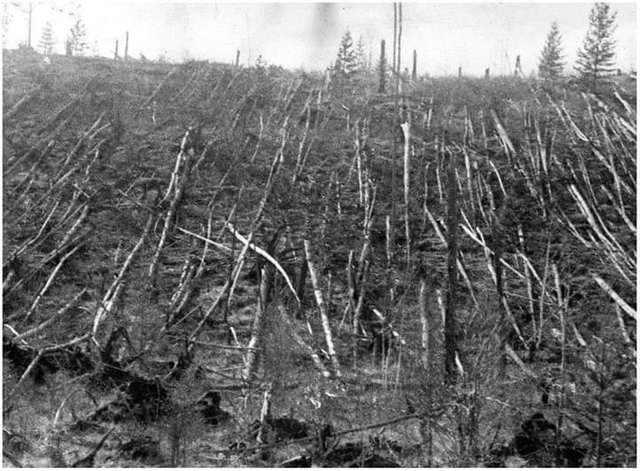Effects of the mysterious explosion of Tongoska - June 30, 1908

Effects of the mysterious explosion of Tongoska - June 30, 1908
The explosion of Tongoska disaster occurred at 7:17 on June 30, 1908 near the Tongoska River in Podkennaya (Afinkia, Siberia in Russia).
Tunguska's phenomenon has left more than 30 hypotheses and theories about the reality of what has occurred, some of which seemed reasonable and acceptable as a guilty collision with the earth and others illogical like a shipwreck or a flying saucer over the region.
Russian scientific missions followed a 19-year-old survey of the accident. Scientists did not venture to explore the devastated area. They were hesitant to go to a swampy area and very far away. Eventually, when they arrived, they were struck by the vast destruction they saw. Lying in rows along the horizon. They searched unsuccessfully for a volcanic crater in the area, trying to find fragments of a meteorite, asteroid or space object but found nothing.
Geologist Leonid Kulik of the Soviet Academy of Sciences was the first to visit the site in 1927 heard from eyewitnesses in nearby villages who spoke of seeing a fireball piercing the sky page with terrifying noise followed by an explosion that drove people to jump in panic. Kulik understood that something unprecedented had happened in the region and the fallen trees in the system were the only evidence of its occurrence.
In the 14 years following the explosion, four more expeditions were sent to Tunguska, headed by Kulik, and the trees were photographed and the marshes and water pools were searched for the meteorite fragments to no avail. Among the dozens of testimonies recorded were contradictory accounts. Almost half of the witnesses confirmed that they saw a fireball burning north, while others claimed that it had passed through a western or northwestern route. Despite this contradiction, Kulik was convinced that Nizka had caused the destruction.
Kulik died in 1942 as a prisoner of war and the expedition stopped. No one visited the area until the late 1940s when Alexander Kazantsev, an engineer from the Russian army, presented a short story in 1946, in which he assumed that this mass destruction could not have been a meteorite but was caused by a nuclear explosion. Reached a nuclear explosion must be the cause of a spacecraft or an explosive plane. This story was re-published in the Soviet Union several times and young Siberian scientists tried to validate this theory, which was written in a book entitled "Guest from Outer Space". They expected to solve this mystery within two years, but they were wrong. Two scientific expeditions were sent to the region in 1959 and 1960, in search of evidence of elevation of the radiation level and site exploration for shrapnel fragments without finding any physical evidence, leading scientists to assume that the matter was more complex than imagined. For two decades, especially since the area was closed and foreigners were banned from carrying out research on Soviet military technology. But the latest evidence to explain this exciting event is that the cause of the explosion is due to the collision of our land with a very fine black hole about a million centimeter radius, and it has a terrible pull. When he approached our land more quickly than the speed of his escape from them collided with and then penetrated and left them to disappear into space...